Lifetime Estimation and Orientation Effect Based on Long-Term Degradation Analysis of Thermoset and Thermoplastic Insulators
Abstract
:1. Introduction
2. Methodology
3. Experimental Set-Up
- HS: SiR Insulator with a Horizontal Orientation
- VS: SiR Insulator Oriented Vertically
- HT: TPE Insulator, Horizontally Oriented (HT)
- VT: TPE Insulator, Vertically Oriented (VT)
4. Results and Discussions
4.1. Visual Interpretations
4.2. Hydrophobicity
4.3. Current Leakage
4.4. FTIR
4.5. Chalking Analysis
4.6. Life Estimation by Regression Analysis
5. Conclusions
Author Contributions
Funding
Acknowledgments
Conflicts of Interest
References
- Akbar, M.; Ullah, R.; Alam, S. Aging of silicone rubber-based composite insulators under multi-stressed conditions: An overview. Mater. Res. Express 2019, 6, 102003. [Google Scholar] [CrossRef]
- Abd Rahman, R.; Harid, N.; Haddad, A. Stress control on polymeric outdoor insulators. In Proceedings of the 45th International Universities Power Engineering Conference UPEC2010, Cardiff, UK, 31 August–3 September 2010; IEEE: Piscataway, NJ, USA, 2010; pp. 1–4. [Google Scholar]
- Schneider, H.; Guidi, W.W.; Nicholls, C.W.; Hall, J.F.; Burnham, J.T. Accelerated aging chamber for nonceramic insulators. Power Technol. Int. 1992, 1992, 105–110. [Google Scholar]
- Schneider, H.; Guidi, W.W.; Burnham, J.T.; Gorur, R.S.; Hall, J.F. Accelerated aging and flashover tests on 138 kV nonceramic line post insulators. IEEE Trans. Power Deliv. 1993, 8, 325–336. [Google Scholar] [CrossRef]
- Ahmad, F.; Akbar, M.; Ullah, R. AC performance of HTV-SR and its hybrids loaded with nano-/micro-silica/ATH fillers. Arab. J. Sci. Eng. 2021, 46, 1103–1114. [Google Scholar] [CrossRef]
- Akbar, M.; Ullah, R.; Abdul Karim, M.R. Interpreting surface degradation of HTV silicone rubber filled with micro/nano-silica Under AC and DC Voltages. J. Electron. Mater. 2020, 49, 5399–5410. [Google Scholar] [CrossRef]
- Sundararajan, R.; Olave, C.; Romero, E.; Kannan, A.M. Impedance analysis of long term aged thermoplastic elastomeric insulators. In Proceedings of the 2007 Annual Report-Conference on Electrical Insulation and Dielectric Phenomena, Vancouver, BC, Canada, 14–17 October 2007; IEEE: Piscataway, NJ, USA, 2007. [Google Scholar]
- Abd-Rahman, R.; Haddad, A.; Kamarudin, M.S.; Yousof, M.F.M.; Jamail, N.A.M. Dynamic modelling of polluted outdoor insulator under wet weather conditions. In Proceedings of the 2016 IEEE International Conference on Power and Energy (PECon), Melaka, Malaysia, 28–29 November 2016; IEEE: Piscataway, NJ, USA, 2016; pp. 610–614. [Google Scholar]
- Ahmed, R.; Abd Rahman, R.; Jamal, A.; Salem, A.A.; Saman, B.; Lau, K.Y.; Ghoneim, S.S. Field-Dependent Pollution Model under Polluted Environments for Outdoor Polymeric Insulators. Polymers 2022, 14, 516. [Google Scholar] [CrossRef]
- Ahmed, R.; Kim, T.; Lee, Y.J.; Jeon, S.; Yi, J.; Choi, I.H.; Son, J.A.; Koo, J.B. Online condition monitoring and leakage current effect based on local area environment. Trans. Electr. Electron. Mater. 2020, 21, 144–149. [Google Scholar] [CrossRef]
- Ullah, I.; Akbar, M. Anti-aging characteristics of RTV-SiR aided HV insulator coatings: Impact of DC polarity and fillers. Mater. Chem. Phys. 2022, 278, 125634. [Google Scholar] [CrossRef]
- Zaghloul, M.Y.; Zaghloul, M.M.; Zaghloul, M.M. Influence of stress level and fibre volume fraction on fatigue performance of glass fibre-reinforced polyester composites. Polymers 2022, 14, 2662. [Google Scholar] [CrossRef]
- Ullah, I.; Amin, M.; Nazir, M.T.; Hussain, H. Impact of accelerated ultraviolet weathering on polymeric composite insulators under high voltage DC stress. CSEE J. Power Energy Syst. 2020, 8, 922–932. [Google Scholar]
- Ullah, R.; Akbar, M. Effect of AC stressed aging on partial discharge, thermal and tensile performance of silicone rubber-based composites. Compos. Commun. 2021, 24, 100634. [Google Scholar] [CrossRef]
- Ullah, R.; Akbar, M. Lifetime estimation based on surface degradation and characterization of HTV silicone-rubber based composites for HVAC and HVDC transmission. CSEE J. Power Energy Syst. 2020, 1–8. [Google Scholar] [CrossRef]
- Zhu, Y.; Zhang, X.; Zhou, S.; Fang, J. Ageing Performance of HTV Silicone Rubber Used for Outdoor Insulation. In Proceedings of the 2018 IEEE/PES Transmission and Distribution Conference and Exposition (T&D), Denver, CO, USA, 16–19 April 2018; IEEE: Piscataway, NJ, USA, 2018. [Google Scholar]
- Salem, A.A.; Abd-Rahman, R.; Ahmad, H.; Kamarudin, M.S.; Jamal, N.A.M.; Othman, N.A.; Ishak, M.T. A new flashover prediction on outdoor polluted insulator using leakage current harmonic components. In Proceedings of the 2018 IEEE 7th International Conference on Power and Energy (PECon), Kuala Lumpur, Malaysia, 3–4 December 2018; IEEE: Piscataway, NJ, USA, 2018; pp. 413–418. [Google Scholar]
- Sundararajan, R. Long term acid rain multistress performance of Thermoplastic and thermoset polymeric insulators. In Proceedings of the 2010 5th International Conference on Industrial and Information Systems, Karnataka, India, 29 July–1 August 2010; IEEE: Piscataway, NJ, USA, 2010. [Google Scholar]
- Venkatesulu, B.; Thomas, M.J. Long-term accelerated weathering of outdoor silicone rubber insulators. IEEE Trans. Dielectr. Electr. Insul. 2011, 18, 418–424. [Google Scholar] [CrossRef]
- Ashwini, A.; Ravi, K.; Vasudev, N. Experimental Study on Aging of Polymeric Insulators by Dip Method. In Proceedings of the 2019 International Conference on High Voltage Engineering and Technology (ICHVET), Hyderabad, India, 7–8 February 2019; IEEE: Piscataway, NJ, USA, 2019. [Google Scholar]
- Bencherif, Y.; Mekhaldi, A.; Lobry, J.; Olivier, M.; Poorteman, M.; Bonnaud, L. Multiscale Analysis of the Polymeric Insulators Degradation in Simulated Arid Environment Conditions: Cross-Correlation Assessment. J. Electr. Eng. Technol. 2020, 15, 135–146. [Google Scholar] [CrossRef]
- Verma, A.R.; Reddy, B.S. Interpretation of surface degradation on polymeric insulators. Eng. Fail. Anal. 2019, 95, 214–225. [Google Scholar] [CrossRef]
- Zhu, Y.; Zhang, X.; Fang, J. Influence of environmental factor on hydrophobicity transfer of silicone rubber used for outdoor insulation. In Proceedings of the 2017 International Symposium on Electrical Insulating Materials (ISEIM), Toyohashi, Japan, 11–15 September 2017; IEEE: Piscataway, NJ, USA, 2017. [Google Scholar]
- Liang, X.; Zhang, Y.; Yin, Y.; Li, Z. 5000 h Multi-stress Test Procedure for Silicone Rubber Composite Insulators and Its Applications in Long- term Performance Evaluation. Gaodianya Jishu High Volt. Eng. 2012, 38, 2492–2498. [Google Scholar]
- Amin, S. Comparative natural aging of thermoplastic elastomeric and silicon rubber insulators in Pakistan. J. Elastomers Plast. 2012, 44, 115–125. [Google Scholar] [CrossRef]
- Khattak, A.; Amin, M. Accelerated aging investigation of high voltage EPDM/silica composite insulators. J. Polym. Eng. 2016, 36, 199–209. [Google Scholar] [CrossRef]
- Khattak, A.; Iqbal, M.; Amin, M. Aging analysis of high voltage silicone rubber/silica nanocomposites under accelerated weathering conditions. Sci. Eng. Compos. Mater. 2017, 24, 679–689. [Google Scholar] [CrossRef]
- Ullah, I.; Akbar, M.; Khan, H.A. Degradation analysis of RTV-SiR based composites under both polarities DC voltage for insulators coating. Mater. Today Commun. 2021, 29, 102890. [Google Scholar] [CrossRef]
- Ullah, I.; Akbar, M.; Khan, H.A. Enhancement of electrical, mechanical and thermal properties of silicone based coating with aluminatrihydrate/silica for ceramic insulators. Mater. Chem. Phys. 2022, 282, 125972. [Google Scholar] [CrossRef]
- Khan, H.; Mahmood, A.; Ullah, I.; Amin, M.; Tariq Nazir, M. Hydrophobic, dielectric and water immersion performance of 9000 h multi-stresses aged silicone rubber composites for high voltage outdoor insulation. Eng. Fail. Anal. 2021, 122, 105223. [Google Scholar] [CrossRef]
- Khattak, A.; Amin, M.; Ali, M.; Iqbal, M.J. Hydrophobicity investigation and life estimation of silicone rubber nanocomposites. Eng. Mater. Res. 2020, 9, 200–205. [Google Scholar] [CrossRef]
- IEC 60815-2; Guide for the Selection of Insulators in Respect of Polluted Conditions. IEC: Geneva, France, 2008.
- Guide 1, 92/1; Hydrophobicity Classification Guide. Swedish Transmission Research Institute-STRI: Ludvika, Sweden, 1992.
- Ullah, R.; Akbar, M.; Ullah, N.; Otaibi, S.A.; Althobaiti, A. Understanding Variations in the Tracking and Erosion Performance of HTV-SR-Based Composites due to AC-Stressed Aging. Polymers 2021, 21, 3634. [Google Scholar] [CrossRef] [PubMed]
- Sundararajan, R.; Soundarajan, E.; Mohammed, A.; Graves, J. Multistress accelerated aging of polymer housed surge arresters under simulated coastal Florida conditions. IEEE Trans. Dielectr. Electr. Insul. 2006, 13, 211–226. [Google Scholar] [CrossRef]
- Sundararajan, R.; Mohammed, A.; Chaipanit, N.; Karcher, T.; Liu, Z. In-service aging and degradation of 345 kV EPDM transmission line insulators in a coastal environment. IEEE Trans. Dielectr. Electr. Insul. 2004, 11, 348–361. [Google Scholar] [CrossRef]
- IEC 62217:2012; Polymeric HV Insulators for Indoor and Outdoor Use—General Definitions, test Methods and Acceptance Criteria. IEC: Geneva, France, 2012.
- Yoshimura, N.; Kumagai, S.; Nishimura, S. Electrical and environmental aging of silicone rubber used in outdoor insulation. IEEE Trans. Dielectr. Electr. Insul. 1999, 6, 632–650. [Google Scholar] [CrossRef]
- Su, H.; Jia, Z.; Guan, Z.; Li, L. Durability of RTV-coated insulators used in subtropical areas. IEEE Trans. Dielectr. Electr. Insul. 2011, 18, 767–774. [Google Scholar] [CrossRef]
- Sundararajan, R.; Olave, C.; Romero, E.; Trepanier, B. Modified IEC 5000-h multistress aging of 28-kV thermoplastic elastomeric insulators. IEEE Trans. Power Deliv. 2007, 22, 1079–1085. [Google Scholar] [CrossRef]
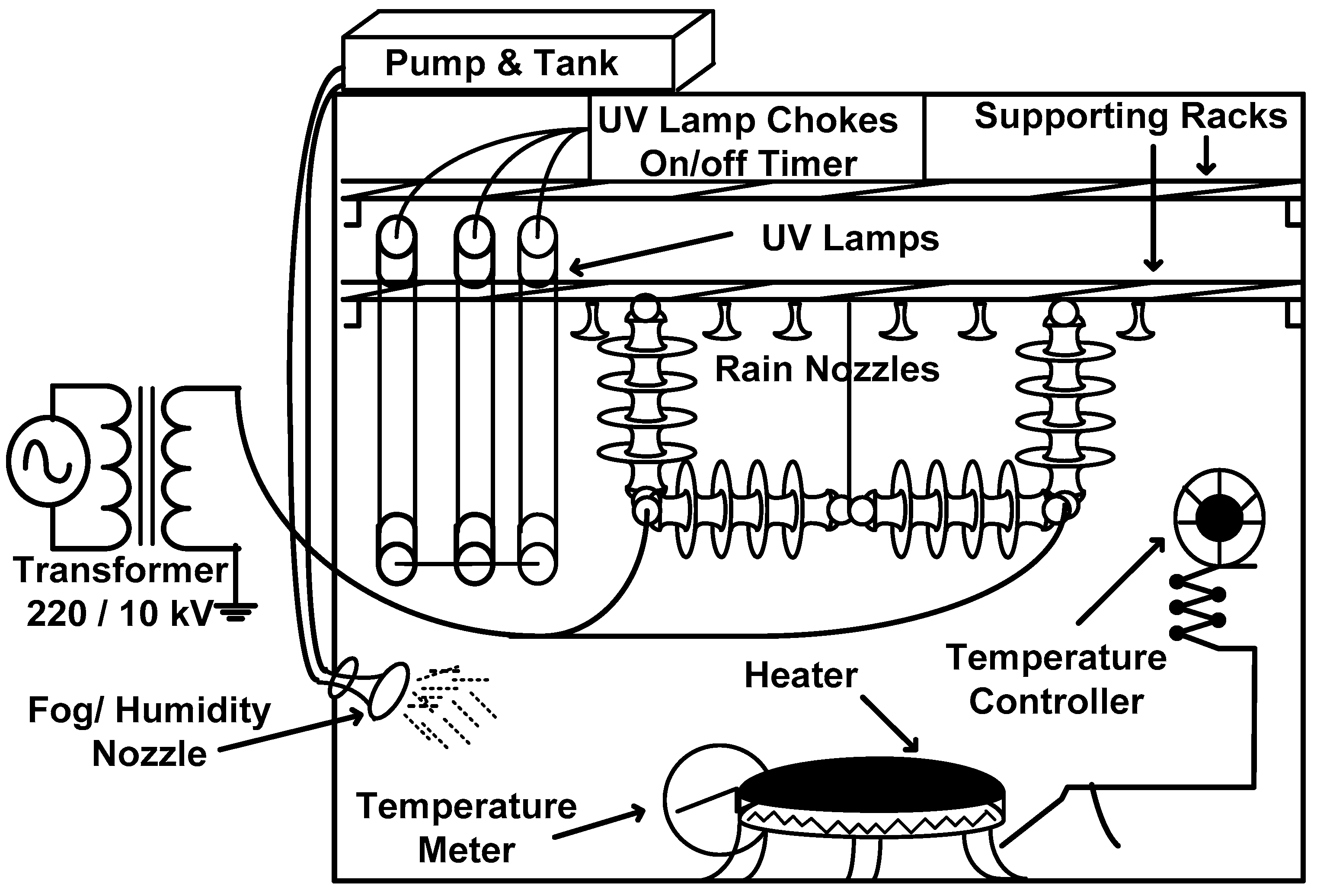

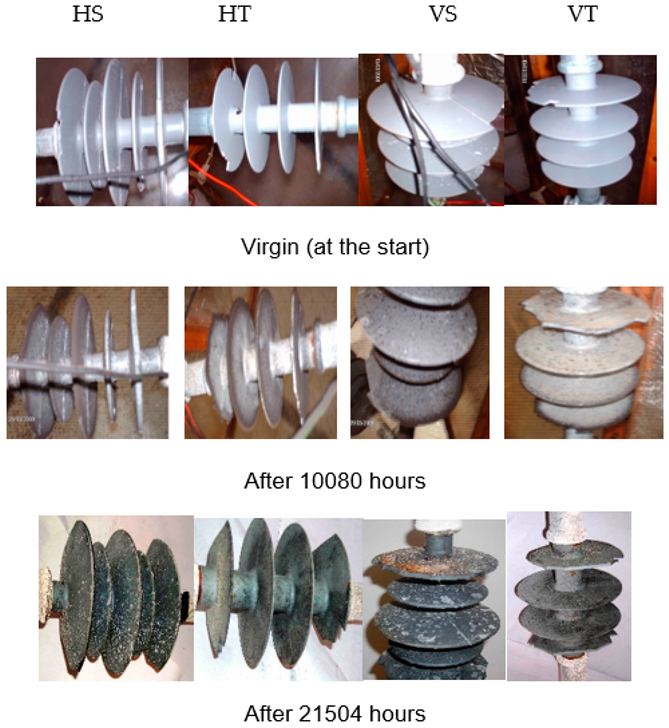
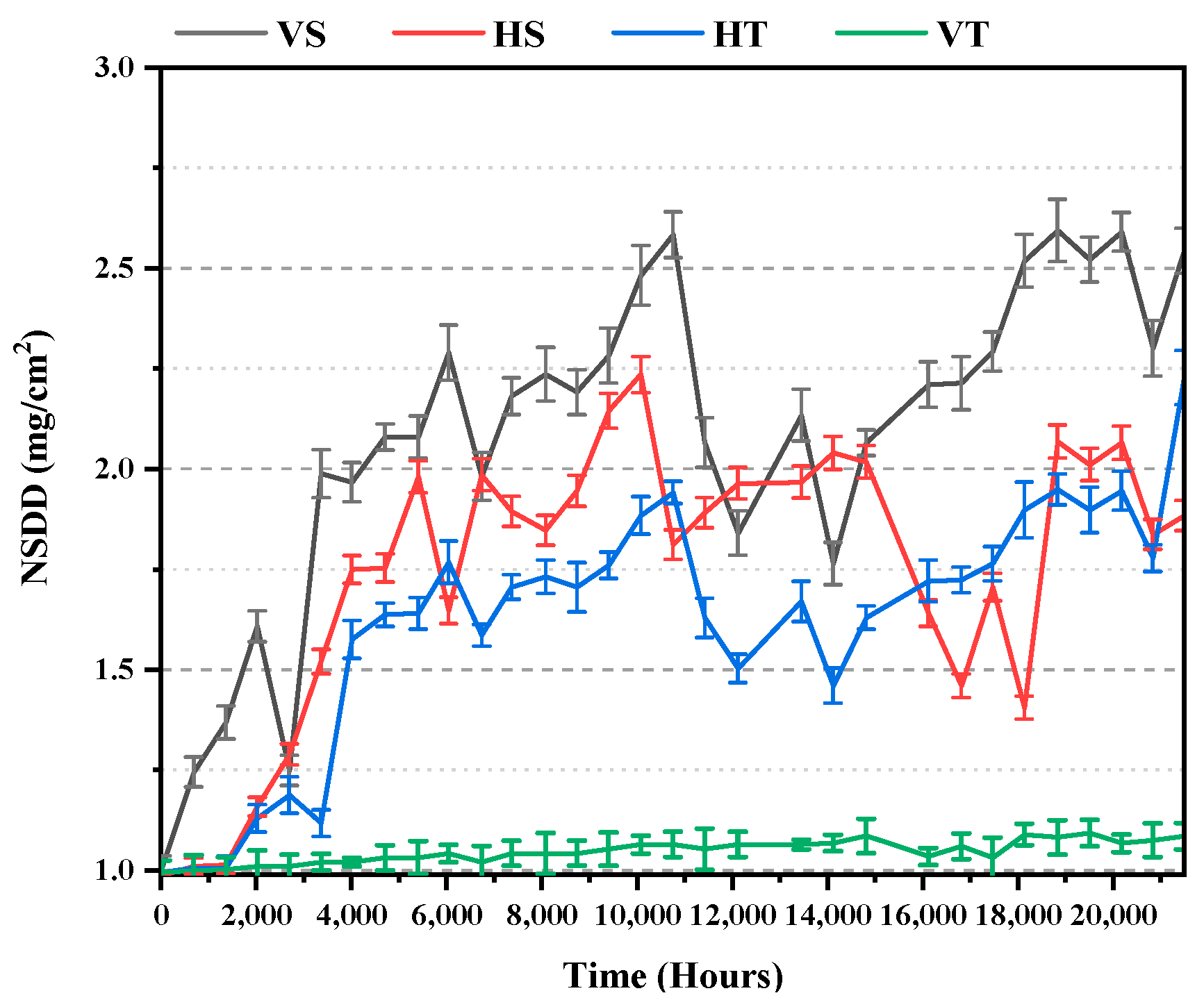
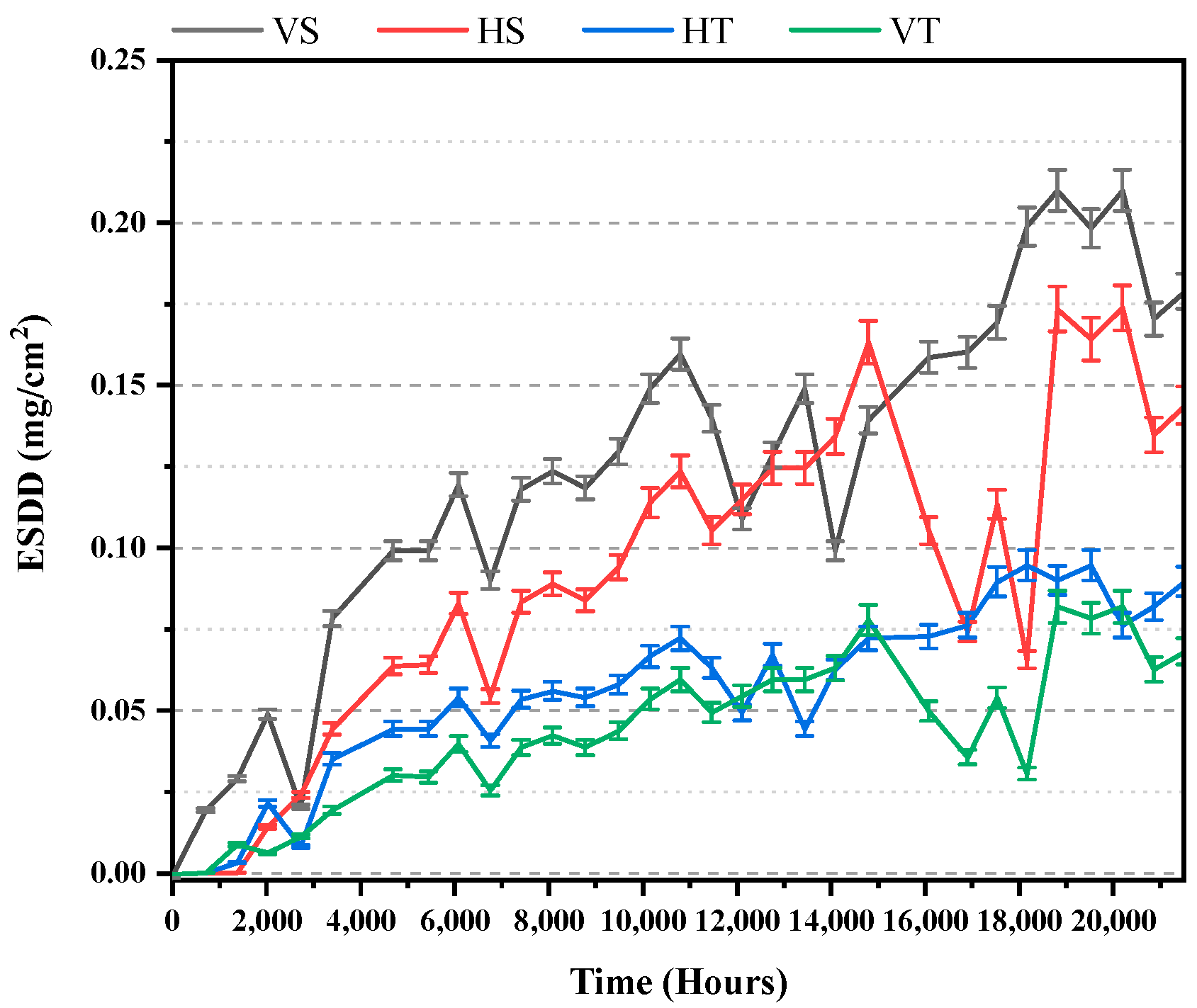
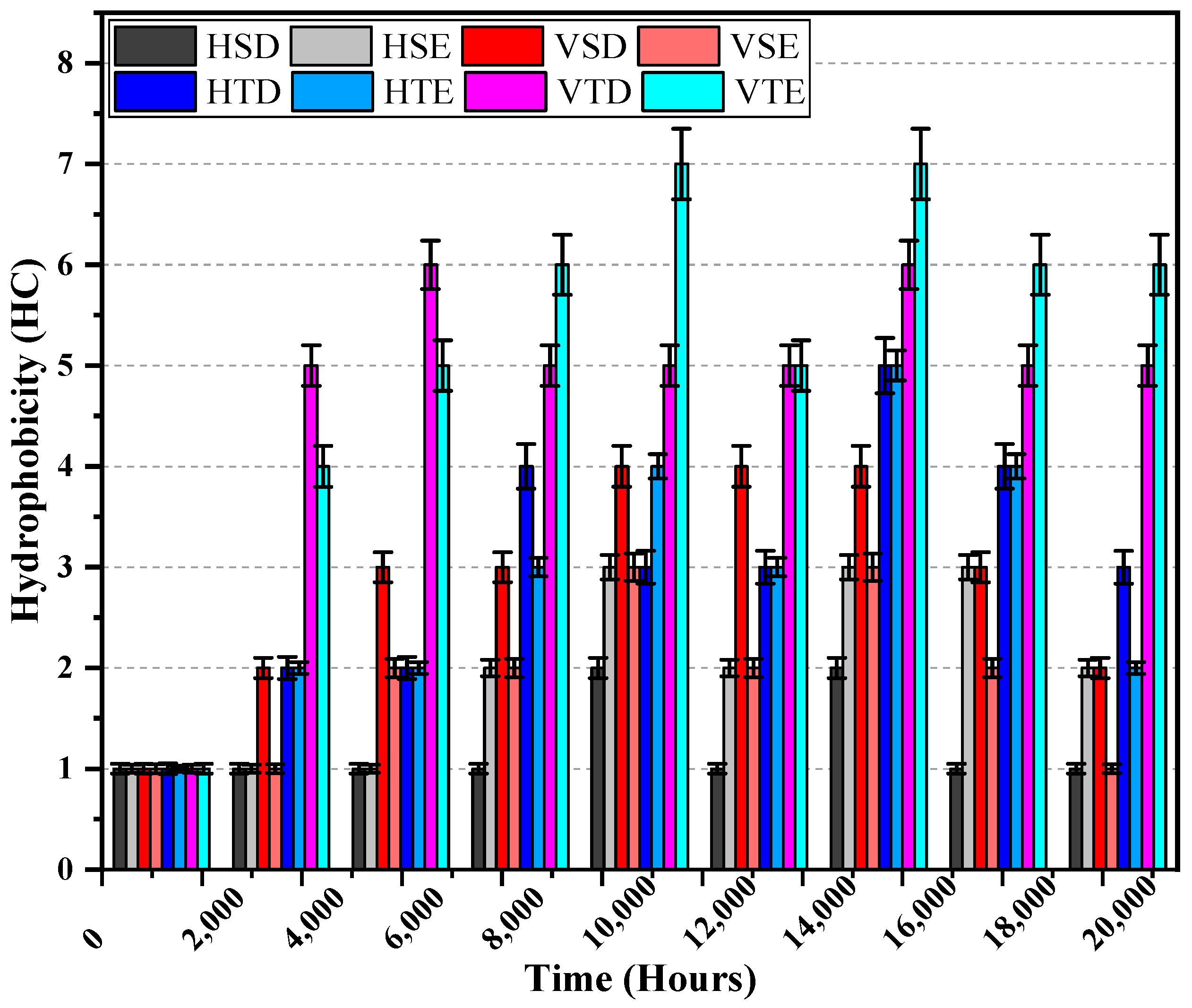

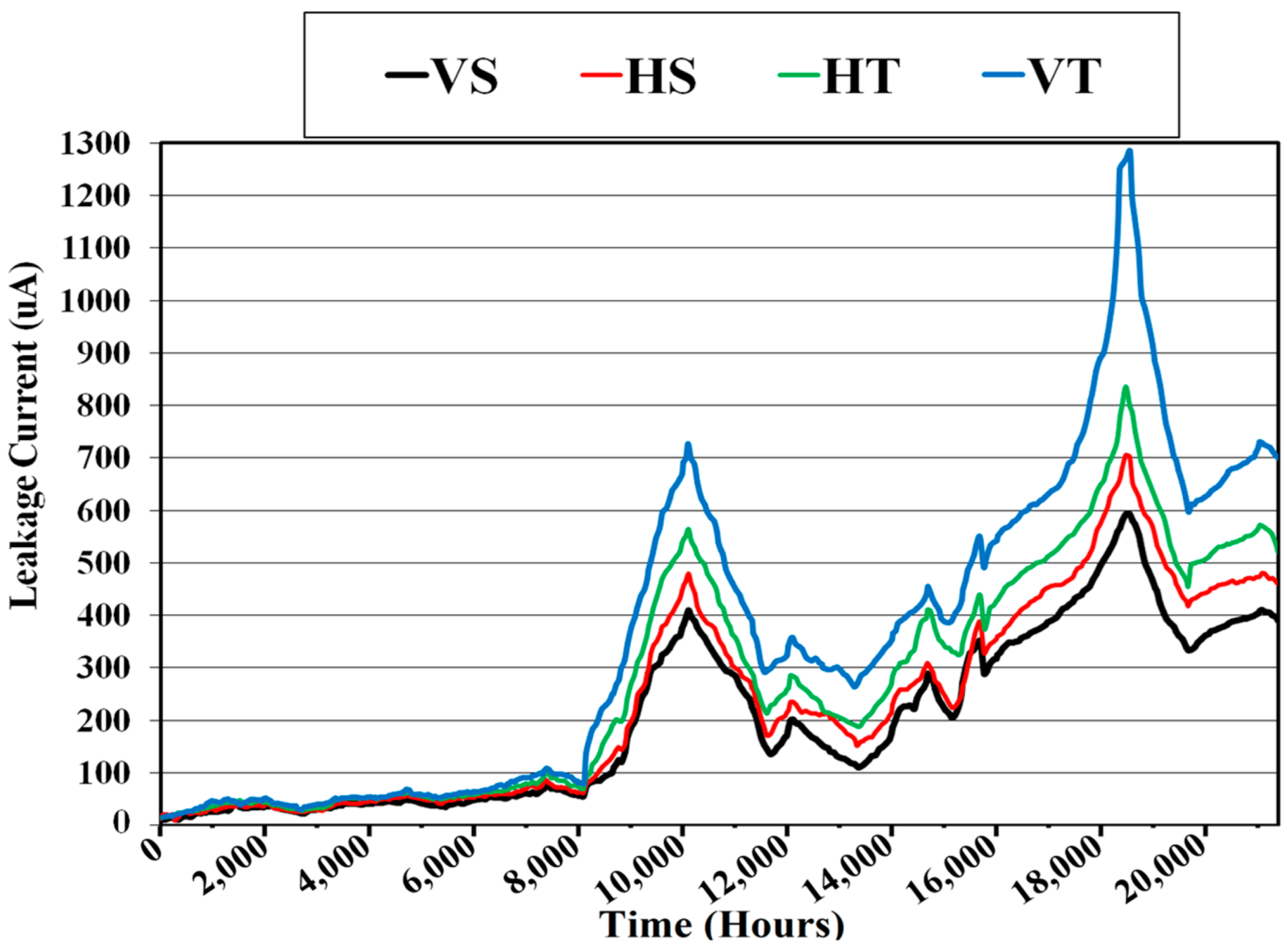
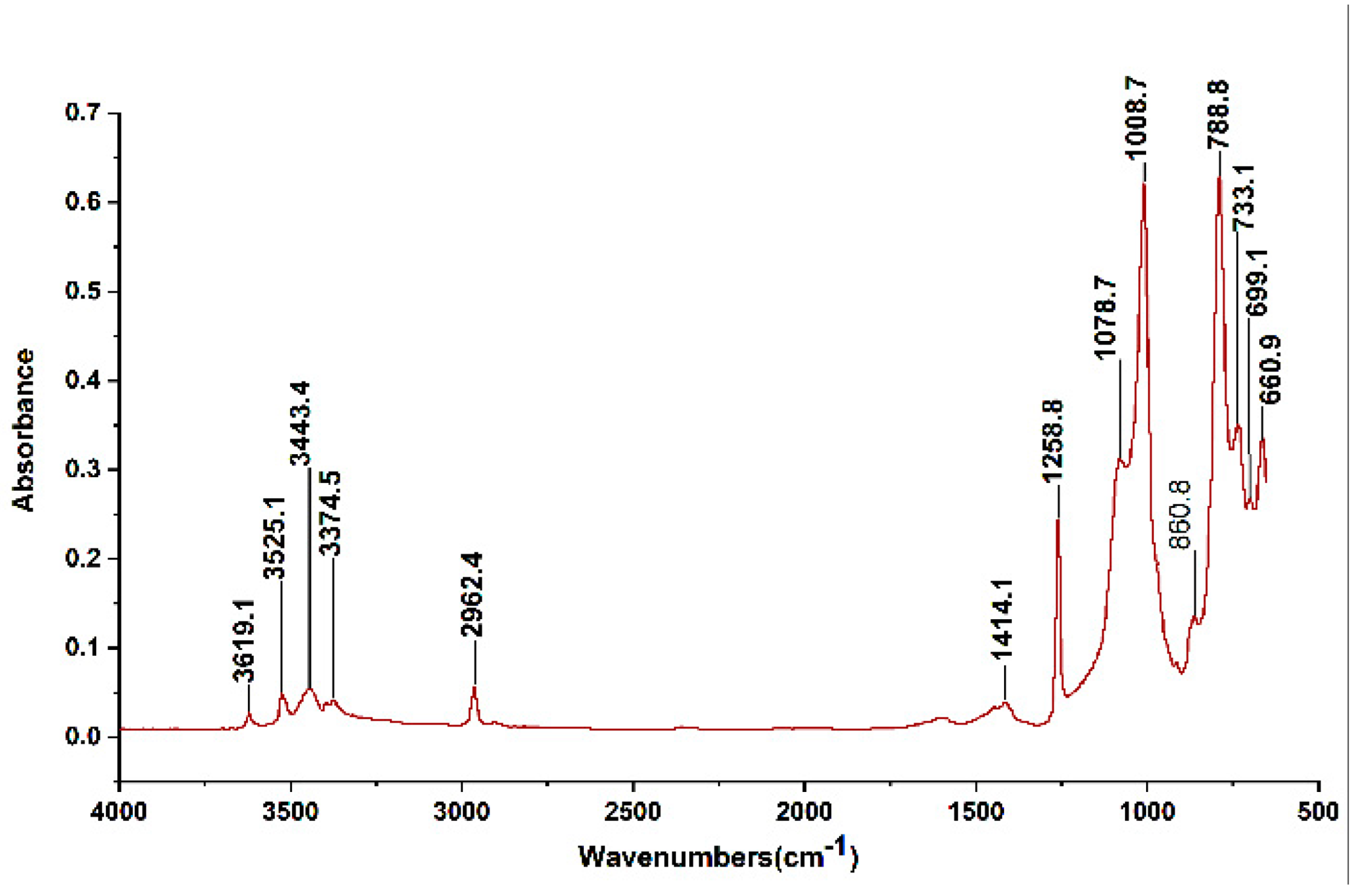
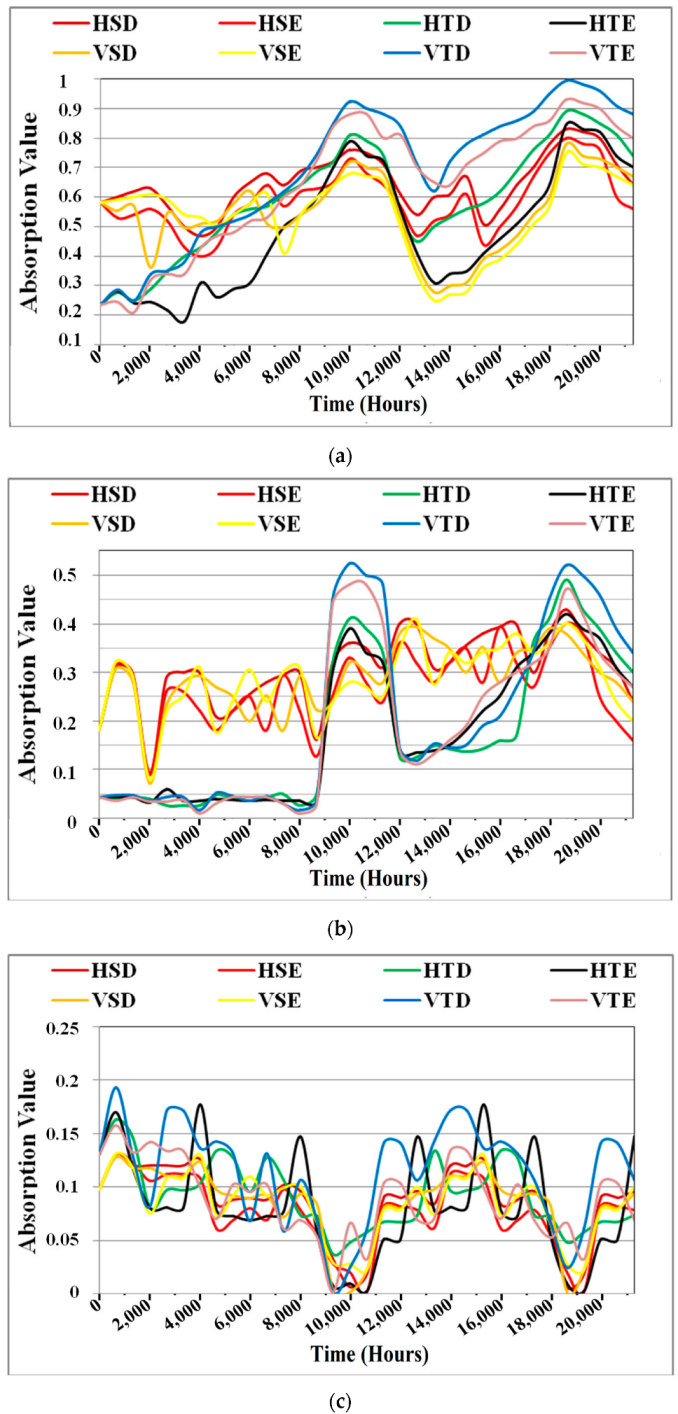
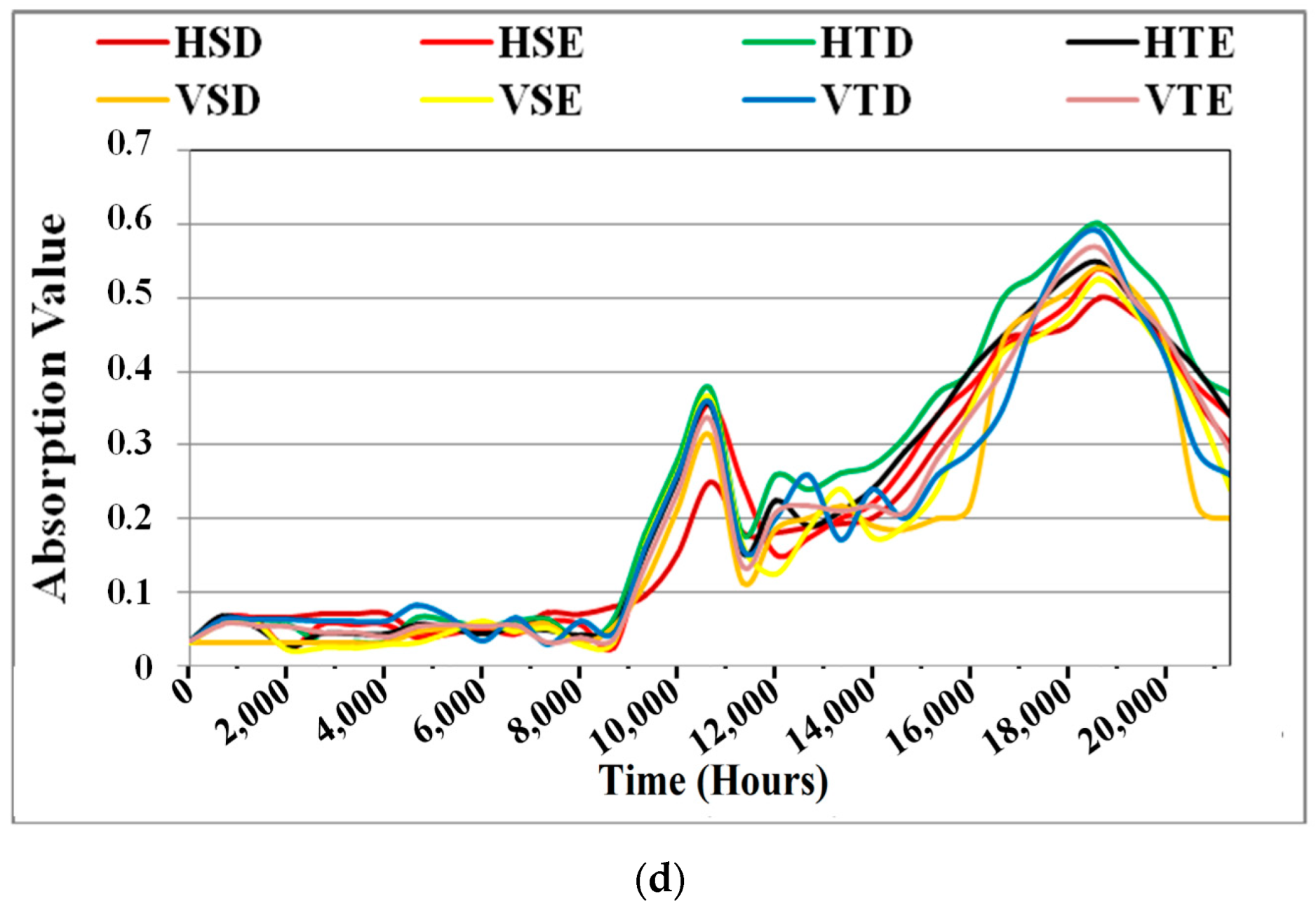

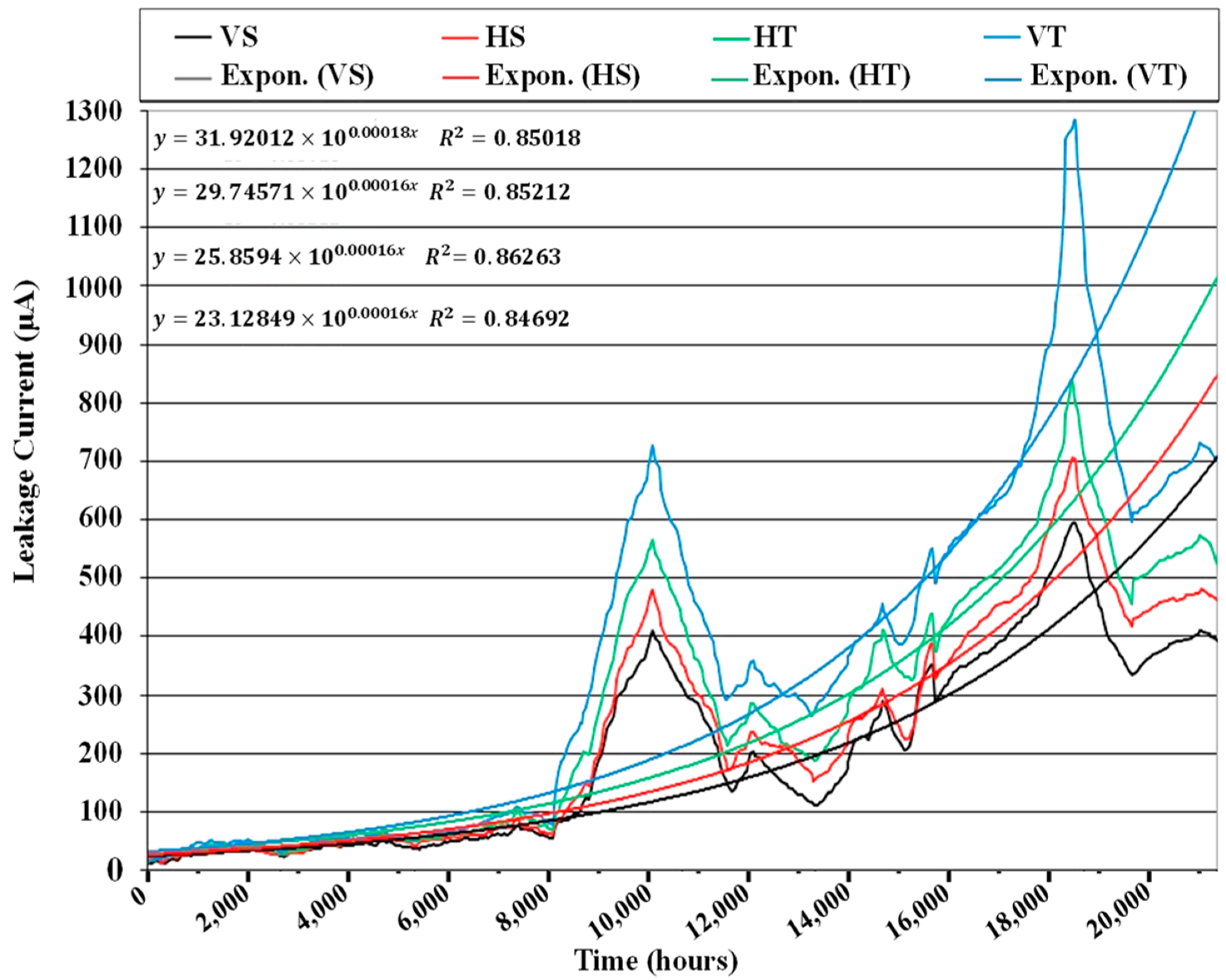
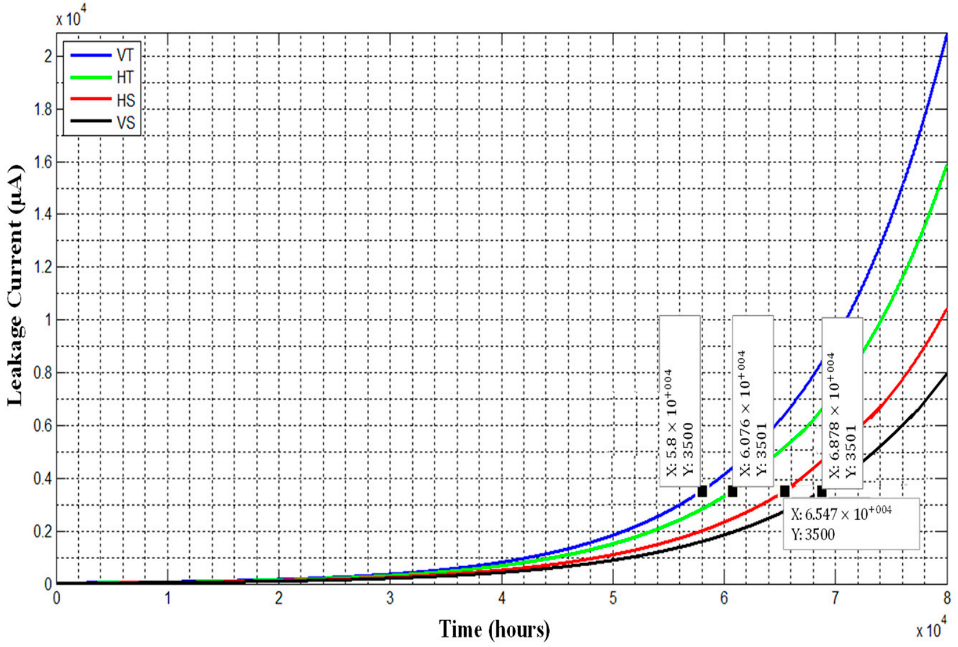
| Item | Winter (October–April) | Summer (May–September) |
|---|---|---|
| UVA radiations | 8 h | 10 h |
| Length of a cycle (days) | 17 | 11 |
| Temperature (°C) | 35.3 | 47.2 |
| Salt fog (6000 μS/cm) | 4 times | 0 |
| Acid rain (4.5 pH) | 2 times | 6 times |
| Numbers of Waves | Functional Groups |
|---|---|
| 3430–3525 | -OH |
| 3392 | SiOH stretching |
| 2917–2922 | Stretching-CH3 |
| 1465–1471 | Asymmetric bending of CH3 |
| 1258 | C-C-C |
| 1014 | Si-O-Si stretching |
| 788–792 | Si-O of Si(CH3)2 |
| Sample Designation | VT | HT | HS | VS |
|---|---|---|---|---|
| From logarithmic | 0.698 | 0.716 | 0.709 | 0.702 |
| From quadratic | 0.872 | 0.889 | 0.890 | 0.876 |
| From exponential | 0.923 | 0.924 | 0.929 | 0.921 |
| Sample Name | Hours to Reach 3.5 mA | Estimated Life (Years) |
|---|---|---|
| VT | 58,000 | 24.2 |
| HT | 60,760 | 25.4 |
| HS | 65,470 | 27.4 |
| VS | 68,780 | 28.7 |
Publisher’s Note: MDPI stays neutral with regard to jurisdictional claims in published maps and institutional affiliations. |
© 2022 by the authors. Licensee MDPI, Basel, Switzerland. This article is an open access article distributed under the terms and conditions of the Creative Commons Attribution (CC BY) license (https://creativecommons.org/licenses/by/4.0/).
Share and Cite
Ullah, I.; Ullah, R.; Amin, M.; Rahman, R.A.; Khan, A.; Ullah, N.; Alotaibi, S. Lifetime Estimation and Orientation Effect Based on Long-Term Degradation Analysis of Thermoset and Thermoplastic Insulators. Polymers 2022, 14, 3927. https://doi.org/10.3390/polym14193927
Ullah I, Ullah R, Amin M, Rahman RA, Khan A, Ullah N, Alotaibi S. Lifetime Estimation and Orientation Effect Based on Long-Term Degradation Analysis of Thermoset and Thermoplastic Insulators. Polymers. 2022; 14(19):3927. https://doi.org/10.3390/polym14193927
Chicago/Turabian StyleUllah, Israr, Rahmat Ullah, Muhammad Amin, Rahisham Abd Rahman, Aftab Khan, Nasim Ullah, and Sattam Alotaibi. 2022. "Lifetime Estimation and Orientation Effect Based on Long-Term Degradation Analysis of Thermoset and Thermoplastic Insulators" Polymers 14, no. 19: 3927. https://doi.org/10.3390/polym14193927
APA StyleUllah, I., Ullah, R., Amin, M., Rahman, R. A., Khan, A., Ullah, N., & Alotaibi, S. (2022). Lifetime Estimation and Orientation Effect Based on Long-Term Degradation Analysis of Thermoset and Thermoplastic Insulators. Polymers, 14(19), 3927. https://doi.org/10.3390/polym14193927







